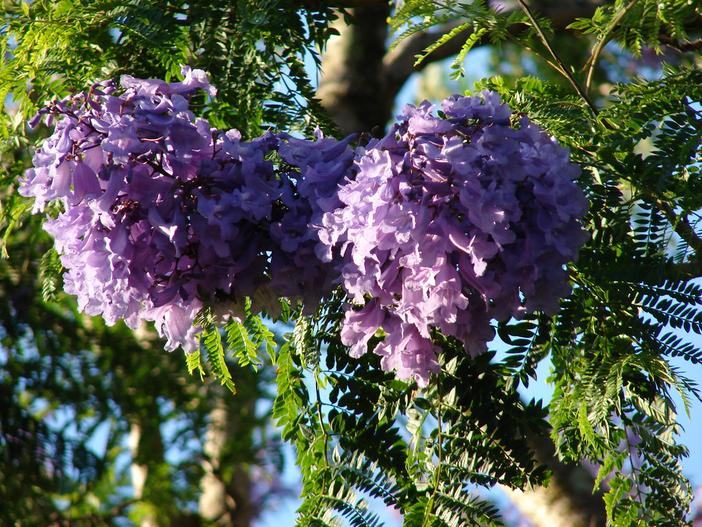Jacaranda
(Jacaranda mimosifolia)
Jacaranda (Jacaranda mimosifolia)
/
/

Forest and Kim Starr
CC BY 2.0
Image By:
Forest and Kim Starr
Recorded By:
Copyright:
CC BY 2.0
Copyright Notice:
Photo by: Forest and Kim Starr | License Type: CC BY 2.0 | License URL: https://creativecommons.org/licenses/by/2.0/ | Uploader: Starr Environmental | Publisher: Flickr












































































































Estimated Native Range
Summary
Jacaranda mimosifolia, commonly known as Jacaranda, is a deciduous or semi-deciduous tree natve to southern Brazil, Paraguay, northern Argentina, and southern Bolivia, where it is often found in open woodlands and savannas. It can grow up to 20 meters (66 feet) tall, with a canopy spread that is nearly as wide. The tree is renowned for its stunning display of purple-blue flowers that bloom in large, showy panicles up to 30 cm (12 inches) long in spring and early summer, lasting for up to two months. These are followed by distinctive woody seed pods, approximately 5 cm (2 inches) in diameter, containing numerous flat, winged seeds. The bark of the Jacaranda is thin and grey-brown, becoming scaly as the tree matures. The foliage consists of large, fern-like bipinnate compound leaves that provide dappled shade.
Jacarandas are widely appreciated for their spectacular floral display and are often used in urban landscaping, along streets, in parks, and as shade trees in large gardens. They are relatively easy to maintain and are valued for their ability to withstand urban conditions. Jacarandas prefer well-drained soils and thrive in full sun, although they can tolerate light shade. They require moderate watering but are somewhat drought-tolerant once established. While they are generally pest-free, they can be susceptible to fungal diseases if conditions are too wet. In areas with cooler climates, Jacarandas may not flower as prolifically. It’s important to note that while Jacarandas are not typically invasive, they can become weedy in suitable climates, and their fallen flowers and seed pods may require regular cleanup.CC BY-SA 4.0
Jacarandas are widely appreciated for their spectacular floral display and are often used in urban landscaping, along streets, in parks, and as shade trees in large gardens. They are relatively easy to maintain and are valued for their ability to withstand urban conditions. Jacarandas prefer well-drained soils and thrive in full sun, although they can tolerate light shade. They require moderate watering but are somewhat drought-tolerant once established. While they are generally pest-free, they can be susceptible to fungal diseases if conditions are too wet. In areas with cooler climates, Jacarandas may not flower as prolifically. It’s important to note that while Jacarandas are not typically invasive, they can become weedy in suitable climates, and their fallen flowers and seed pods may require regular cleanup.CC BY-SA 4.0
Plant Description
- Plant Type: Tree
- Height: 25-50 feet
- Width: 15-30 feet
- Growth Rate: Moderate
- Flower Color: Purple
- Flowering Season: Summer
- Leaf Retention: Deciduous
Growth Requirements
- Sun: Full Sun
- Water: Medium
- Drainage: Fast
Common Uses
Bee Garden, Bird Garden, Border Plant, Butterfly Garden, Drought Tolerant, Fragrant, Hummingbird Garden, Showy Flowers, Street Planting
Natural Habitat
open woodlands and savannas
Other Names
Common Names: Jakaranda, Black Poui, Nupur, Fern Tree, Flamboyán Azul, Jacarandá-Caroba, Jacarandá-Mimoso, Palissandra, Caroba-Guassú
Scientific Names: , Jacaranda mimosifolia, Jacaranda ovalifolia, Jacaranda chelonia, Jacaranda filicifolia,
GBIF Accepted Name: Jacaranda mimosifolia D.Don